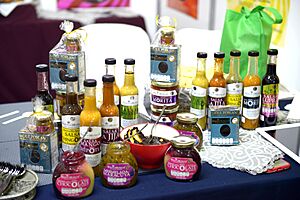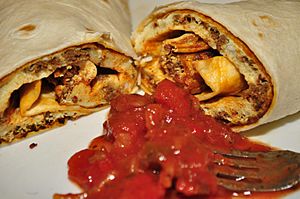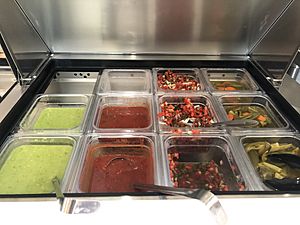Salsa (food) facts for kids

A variety of salsas
|
|
| Type | Condiment |
|---|---|
| Region or state | Mexico |
| Main ingredients | Varies |
Salsa is a popular type of sauce often used as a condiment with many foods. You might know it best with tortilla chips as a dip, or on tacos and other Mexican dishes. Salsa can be made from raw or cooked ingredients. It is usually served at room temperature.
The word salsa actually means "sauce" in Spanish. But in English, when we say "salsa," we usually mean the special Mexican sauces. These often have tomatoes and chili peppers, like the chunky pico de gallo or green salsa verde. In the United States, tortilla chips with salsa are a very common appetizer in Mexican-American restaurants.
Contents
The History of Salsa
How Salsa Became Popular
Salsa became well-known as a table dip thanks to Mexican restaurants in the United States. In the 1980s, salsas made with tomatoes became very popular. By 1992, people in the U.S. were buying more salsa than tomato ketchup!
New Kinds of Salsa
After a while, tomato-based salsas got some competition. New types of salsa started appearing, made with fruits, corn, or black beans. Since the 2000s, sweet salsas have become popular. These combine fruits with spicy peppers like habanero or Scotch bonnet. You might even find these sweet salsas served with desserts like cheesecakes!
In the United States, salsa is used in many ways. It can be a marinade for meat, a dressing for salads, or an ingredient in stews. It's also a tasty topping for baked potatoes, pasta, and even pizza.
Different Types of Salsa
Salsa is a key part of Mexican cuisine. It's served with tacos, mixed into soups, or used as a filling for tamales.

Here are some common types of Mexican salsas:
- Salsa fresca: This means "fresh salsa." It's made with fresh tomatoes and hot peppers.
- Salsa verde: This is a green salsa made with cooked tomatillos. It's often used as a dip or sauce for dishes like chilaquiles and enchiladas.
- Chiltomate: This is a common base sauce made from tomatoes and chiles. The type of chile used changes depending on the region.
- Salsa roja: Meaning "red sauce," this is one of the most common salsas. It usually has cooked tomatoes, chili peppers, onion, garlic, and fresh cilantro.
- Salsa cruda: This means "raw sauce." It's an uncooked mix of chopped tomatoes, onions, jalapeño chilies, and cilantro.
Traditionally, Mexican salsas were made using a special tool called a molcajete, which is like a mortar and pestle. Today, many people use blenders to make salsa.
Keeping Salsa Safe
Why Storage Matters
The WHO says it's important to prepare and store salsa carefully. This is because many salsas are served raw. If they are not kept cold, they can become a place where tiny, harmful bacteria can grow.
Studies on Salsa Safety
In 2002, a study found that some salsas in restaurants had harmful bacteria like E. coli. This happened in 66% of salsas tested in Guadalajara, Mexico, and 40% of those tested in Houston, Texas.
Later, in 2010, the CDC reported that some foodborne illnesses were linked to restaurant sauces that were not prepared or stored properly.
A study in 2010 showed that keeping salsa cold in the refrigerator is "the key" to keeping it safe. This study also found that fresh lime juice and fresh garlic (but not garlic powder) could help stop the growth of harmful bacteria like Salmonella. So, proper storage and fresh ingredients are important for safe and tasty salsa!
See also
 In Spanish: Salsas de la gastronomía mexicana para niños
In Spanish: Salsas de la gastronomía mexicana para niños




